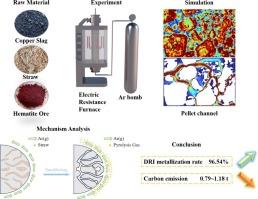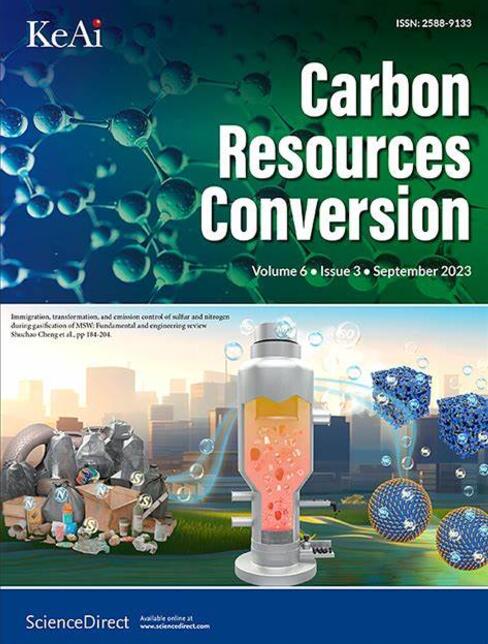铜渣还原过程中孔隙形成机理:实验与模拟相结合的澄清
IF 7.5
3区 环境科学与生态学
Q2 ENERGY & FUELS
引用次数: 0
摘要
铜渣浮选后仍含有大量的铁资源,直接贮存是一种严重的资源浪费。直接还原铁(Direct reducing Iron, DRI)是由铜渣还原而成,需要大量的化石能源,碳排放量大。以秸秆和秸秆炭为还原剂,对浮选铜渣进行还原制备DRI。采用微纳刺激法建立了DRI孔隙模型,分析了生物质铜渣复合球团的直接还原动力学特性。结果表明,秸秆的加入有利于铜渣的直接还原。秸秆热解产生还原性热解气,预还原球团,同时留下气孔,为后续直接还原铜渣改善动力学条件。与无烟煤等传统化石燃料相比,以秸秆和秸秆炭为还原剂制备的DRI还原铜渣的金属化率由85%提高到96.54%。该工艺每生产1吨铁水可减少0.26 ~ 0.52吨碳排放。本研究提出了一种可行、低碳、高效的浮选铜渣处理方法,可以充分回收浮选铜渣中的铁资源,解决了浮选铜渣只能贮存处理的行业难题。有利于促进非高炉炼铁、铜渣综合利用和生物质资源综合利用的有机结合。本文章由计算机程序翻译,如有差异,请以英文原文为准。

Mechanism of pore formation in copper slag reduction: A clarification combining experiments and simulation
Copper slag still contains a large amount of iron resources after flotation, and direct storage is a serious waste of resources. Direct Reduced Iron(DRI) are prepared by reduction of copper slag which requires a large amount of fossil energy and emits carbon largely. In this work, straw and straw charcoal were used as reducing agents to reduce flotation copper slag to prepare DRI. The pore model of the DRI was constructed via micro/nano stimulation, and the direct reduction kinetic characteristics of the biomass copper slag composite pellets were analyzed. The results show that the addition of straw is beneficial for the direct reduction of copper slag. The straw is pyrolyzed to produce a reducing pyrolysis gas to prereduce the pellets while leaving pores to improve the kinetic conditions for the subsequent direct reduction of copper slag. Compared with traditional fossil fuels such as anthracite, the metallization rate of DRI prepared with straw and straw charcoal as reducing agents to reduce copper slag increased from 85 % to 96.54 %. This process can reduce carbon emissions by 0.26 ∼ 0.52 t per ton of molten iron. This study proposes a feasible, low-carbon and efficient flotation copper slag treatment method that can fully recover the iron resources in flotation copper slag and solve the industry problem that flotation copper slag can be stored and disposed of only. It is helpful to promote the organic combination of nonblast furnace ironmaking, the comprehensive utilization of copper slag and the comprehensive utilization of biomass resources.
求助全文
通过发布文献求助,成功后即可免费获取论文全文。
去求助
来源期刊

Carbon Resources Conversion
Materials Science-Materials Science (miscellaneous)
CiteScore
9.90
自引率
11.70%
发文量
36
审稿时长
10 weeks
期刊介绍:
Carbon Resources Conversion (CRC) publishes fundamental studies and industrial developments regarding relevant technologies aiming for the clean, efficient, value-added, and low-carbon utilization of carbon-containing resources as fuel for energy and as feedstock for materials or chemicals from, for example, fossil fuels, biomass, syngas, CO2, hydrocarbons, and organic wastes via physical, thermal, chemical, biological, and other technical methods. CRC also publishes scientific and engineering studies on resource characterization and pretreatment, carbon material innovation and production, clean technologies related to carbon resource conversion and utilization, and various process-supporting technologies, including on-line or off-line measurement and monitoring, modeling, simulations focused on safe and efficient process operation and control, and process and equipment optimization.
 求助内容:
求助内容: 应助结果提醒方式:
应助结果提醒方式:


